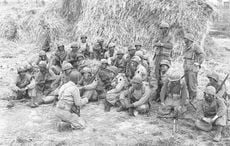Archaeologists discovered a large underground bunker and trench system built during the First World War at a military camp in North Cork.
The underground bunkers at Lynch Camp, Kilworth, were built around 1915 and could have accommodated sleeping quarters for up to 300 troops, reported the Irish Examiner.
A team from Queen’s University Belfast carried out their first reconnaissance of the land in October 2013 after acquiring historical maps showing the huge fortifications at the camp, This was followed by a week-long detailed examination last summer. The team of academics had to acquire permission from the Department of Defence and the Defence Forces to visit the camp, which is located halfway between Fermoy and Mitchelstown.
“We were just blown away with what we found. It is certainly the best preserved in Ireland and is so significant that it could be bigger than anything found in Salisbury Plain (a huge British Army training center in Wiltshire, close to Stonehenge). It’s a really significant find,” said Dr Alistair Ruffell, a geology expert who was co-supervisor on the project.
The massive underground bunker and trenches are today obscured by heather and gorse, so the team employed technologies, such as aerial mapping, GPS, and geophysics, or ground-penetrating radar, to work out the underground fortifications.
READ MORE: How Guinness saved Ireland in World War II.
Dr. Ruffell told the Irish Examiner that the fortifications were built to show troops the reality of life in the trenches and enable them to carry out pre-battle training in conditions similar to what they would encounter at the front.
“It was quite emotional to be in the trenches, for obvious reasons. These were sometimes the last places the young men from Ireland practiced in before they went, often to not return,” he said.
Dr. Ruffel credits the discovery to PhD student Heather Montgomery, who persuaded her colleagues that an investigation of the site might be worthwhile.
Excavations could not be conducted due to a risk of any unexploded shells still buried from that era or later as Kilworth had been a military training camp from the late 1890s to present day.
The Kilworth camp is currently a significant training center for the Defence Forces, with around 4,500 members of the Defence Forces assigned to train there every year. The camp has been refurbished to accommodate 320 troops for exercises and a $1,135,750 (€1m) state-of-the-art automated firing range opened last year.
At this time, it is still unclear what further research, if any, the archaeologists will undertake.
READ MORE: Details of poison gas attack on Irish soldiers in World War I emerge.
* Originally published in February 2015.




Comments